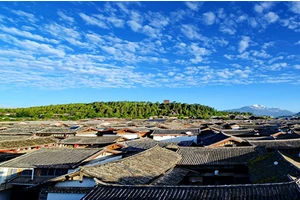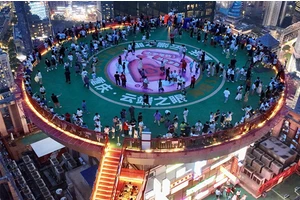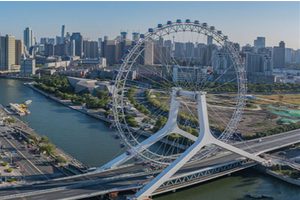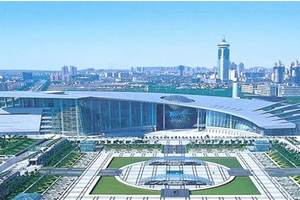Xinjiang travel outdoor
Day D: Assemble at 6 am and leave at 6: 30.
Since 2009, a larger coal mine has been discovered in Baiyanggou, a new simple highway has been built, and it has extended to the mountains for nearly ten kilometers. For mountain friends who walk the Wolf Tower, they can walk about ten kilometers less. The simple highway runs along the Baiyang River. After about ten kilometers, it reaches a fork in the river, turns south and enters the mountain (it is said that there are still eight kilometers to the new coal mine). There are several large canvas tents here, which are inhabited. This is our starting point for hiking. We still continue to move southwest and along the Baiyang Valley. About an hour later, the Baiyang River also turned due south, and we continued along the Baiyang River and went up against the river. Cross the river several times on the way, but you can also climb the mountain to bypass it.
I camped in a sheepfold in the valley today. Flat and comfortable. It is close to the water source. You can also continue to drive for two hours, and there are flat grass stalls where you can camp.
Bus route: Urumqi-Hutubi Baiyanggou Coal Mine is about 150 kilometers away and takes three hours. When the number of people is appropriate, it is most convenient to go by chartered bus, which can save a lot of time.
Specific route: Urumqi ---G312 Wuchang Avenue (or Wukui Expressway)-changji city-(If you go to Hutubi County by chartered bus, you don't need to enter Hutubi County. If you want to take the Wu-Kui Expressway, you need to get off at the Hutubi exit)-Turn south in Dafeng Town-Queergou Township-Intersection of Provincial Highway 101-Baiyanggou Coal Mine-Continue along Baiyang River for about 9 kilometers-Starting point on foot.
Walking for 6-8 hours all day, the journey is 15-20 kilometers, and the altitude rises by about 1000 meters.
D2 Day: Depart at 9: 00 a.m. and cross Baiyanggou Osaka.
Starting from the sheepfold camp, go up along the Baiyang River. When the water is small, you can walk along the river bed, and the slope fluctuates slightly. When the water is heavy, you can walk along the horse paths on both sides of the river. There is a big slope fluctuation. About 3-5 hours, I came to a hill in front of Osaka, where the river was out of sight. You can follow the horse path on the west side (right hand side) and go straight to the foot of Osaka, where the altitude is 3200 meters. You can see the glaciers on the west side of Osaka, as well as the horse road in Upper Osaka. Osaka is on the left. You can rest here and eat something to replenish your strength. At this time, I can't see the pass of Baiyanggou Osaka. You can climb Osaka along a clear horse path on the gravel slope. It takes about 1.5-3 hours to reinstall. On the way to Osaka, there is a clear path, which is first in the right hand direction, and then changed to the left hand direction after passing the saddle ridge camp. However, the slope of some sections is more than 45 degrees, so it is difficult to cut obliquely, especially in rainy and snowy weather, so you should be especially careful.
It takes 2-4 hours from the top of Osaka (3,860m) to the nearest camp-Maanshan Camp (2,900m). Plan your time. So as not to miss the camp.
Today's journey is 20 kilometers, the altitude rises by 1100 meters and falls by 1000 meters, which takes about 10 hours.
D3: Depart at 9:00 a.m.. Aerial plank road
When you descend 200 meters from Maanshan camp, you will reach a small river valley, and sometimes there is a lot of water. Cross the wooden bridge. Climb over a big stone again, and the plank road in the air will begin. There are three sections of plank roads that are not too long. After that, climb a slope with a slope of 50 degrees and about 100 meters, and climb to the top of the slope, and you will see the Taipu Ximak River. But to reach the valley, it is necessary to cut a slope with a slope of 45 degrees and a length of about 500 meters. After arriving at the river valley, you will travel all the way along the river valley. In the middle, you will repeatedly switch between wooden bridges, horse paths and plank roads, and you need to wade two or three times.
Attention should be paid to a place called "Tiger Mouth" in this section of the road. The horse path in this section was cut off by a landslide, and it is no longer possible to pass. It is necessary to bypass the mountain ridge on the right side. The bypass road has a slope of more than 45 degrees, dense thorns and is difficult to walk.
After crossing the Tiger Mouth, go forward about 1 km, cross a wooden bridge, and have a rest after crossing the bridge.
Since then, the longest and most difficult aerial plank road has begun. This plank road is about 4 kilometers long. With the repeated rise and fall of altitude, some plank roads are not more than half a meter wide, and there are slippery roads. It takes about 2-4 hours to walk. When the river is small, you can also swim upstream along the river. However, due to the low water temperature, physical energy consumption is also great, and continuous wading can easily lead to temperature loss, which requires special attention.
Out of this plank road, there is a camp and a small grass platform, which is very flat. You can see the main peak of Wolf Tower about 15 kilometers away. It's beautiful. If you're lucky, you can get a picture of the Wolf Tower Golden Summit.
Today's journey is 18 kilometers, and the altitude has risen by 800 meters and fallen by 800 meters, which takes about 10 hours.
D4: Depart at 9:00 am. Kule Ateng Osaka (3555 m)
From Xiaocaotai camp, walk 100 meters ahead, and on the left hand side is a small river ditch. There is a small tree at the mouth of the ditch. In autumn, the tree is covered with small red fruits. At this time, it is necessary to turn left into the small river ditch and go up against the river. This river flows down from Osaka. When I first entered Xiaohegou, it was relatively narrow, and then gradually widened, and the road became clear. The last 300 meters near the top of Osaka is a quicksand slope with a slope of about 60 degrees. After October, the horse track on the top of Osaka will also be covered with snow. We should carefully find the traces of the horse track, otherwise it will be difficult to climb to the top of Osaka. The journey takes about 3-5 hours.
Then the 1400-meter descent. Arrive at Telantagou. It also takes 3-5 hours. After reaching the bottom of the ditch, you need to wade repeatedly. When the water is heavy, you should use ropes to protect it.
If the team is physically fit, after reaching the bottom of the ditch, they can continue to go upstream against the river. When they see the second ditch in the left hand direction, they turn left and enter. At this time, the direction is basically due south (this ditch is very easy to go wrong, so be careful to identify it. The water in the ditch is relatively large, and they will climb a hill about 10 meters after crossing the river). After repeated wading for about 3 kilometers, there is a herdsman's house on the left hillside for two hours. This is today's camp. Every year at 10.1, the herdsman is still here. You can buy a sheep and rest for half a day to a day. So that the team can regain its strength. The scenery here is also very beautiful, which is the core area of Wolf Tower.
Today's journey is 20 kilometers, the altitude rises by 1000 meters and falls by 1400 meters, and the time is about 10 hours.
D5: Depart at 9:00 a.m.. Crossing Montekaizen Osaka (3,960 meters) and Karagayit Osaka (3,700 meters) is the day with the strongest crossing intensity of Wolf Tower.
Walk along the herdsmen's house camp for about 4 kilometers. After one and a half hours, you will arrive at the fork of Montekaizenosaka. Here, go straight to the south slightly west (right) and go along the main river, which is Lantaizenosaka (another way to cross the Wolf Tower). Enter a smaller valley on the left, and the direction is southeast, which is the direction of Montekaizen Osaka.
This time, we will take the direction of Montekai and Osaka. The altitude here is about 2900 meters. Along the horse road, about 2 hours later, there is a small ice lake in an open area before arriving in Osaka, where you can have a rest and gather the team. (At this time, there is an ice Osaka just to the right in front of you, but note that it's not Montekaizeng Osaka. This ice Osakanoe also has Mani Pile, which is about 3860 meters high, slightly lower than Montekaizeng Osaka. Once, some teams mistakenly mistook this ice Osaka for Montekaizen Osaka, and even ventured down the mountain from the top of Osaka. The road was very dangerous. Finally, they forcibly ventured down and obliquely inserted into the horse road connecting Montekaizen Osaka and Kanagayit before returning to the correct route. This is also a very easy intersection for Wolf C, which needs special attention. )
Continue to go along the gravel slope to the left of the previous strategy. Sometimes the path is not clear enough, so you need to look for it carefully. About an hour later, we arrived at the foot of Monte Kai Zeng Bing Osaka, which is 3600 meters above sea level. When the weather is clear, you can see the whole picture of Osaka Pass and Montekaizen Glacier about 800 meters long and 300 meters wide.
There are no horse tracks on both sides of the mountain, so you can only walk along the glacier. It is about 100 meters away from the pass. There is a horse track on the right hillside. At this time, it is best to cut to the right. After reaching the horse track, you can easily climb up Montekaizeng Osaka. It takes 2-3 hours.
From the top of Montekaizen Osaka, there is a ridge connecting Kanaga Itosaka. There is a horse path on the ridge, but it is sometimes hidden in the rubble, so we must look for it carefully. This section of the horse path is always on the right hand side, and it takes about one hour to reach the top of Kanaga Itosaka.
Kanaga Itosaka is a three-pronged Osaka, and there are three roads passing through Osaka. The correct route is to get off Osaka in the due west direction (right-hand direction), and the horse path in this direction is also the widest, and you will reach Hargat Golog Valley. Choose a suitable camp according to the travel time of the team. Most teams, after crossing these two Osaka, will get dark, so they can only find a relatively flat hillside to camp on the way to Xiaosaka. But it is difficult to find an ideal camp. If the team is fast, you can go down along the horse road in Lower Osaka to the bottom of Hargat Golog ditch, where the two rivers meet. It is very flat and has a low altitude, which is more suitable for camp. It takes 2-4 hours from Osaka to the bottom of the ditch, and the distance is 10 kilometers.
Today, the journey is 20 kilometers, the altitude rises by 1400 meters, and falls by 500-1000 meters, which takes 10 hours.
D6 Day: Depart at 9:00 am. Ha' ergate Guole Prairie
Follow the horse road and reach the bottom of Hargat Golog ditch, after the intersection of the two rivers. You can continue to walk along the river for 200 meters, then wade across the river, along the horse road, cross a not too high Osaka and reach the Hargat Golog Prairie, which takes about 3 hours. You can also wade directly after reaching the intersection of the two rivers (you must observe the amount of water, on the premise of ensuring safety), and go upstream against the river. You need to wade across the river repeatedly in the middle. After about one hour, you can reach the Hargat Golog Prairie.
After arriving in the prairie, walk along the horse path on the right bank of Hargat River and find a suitable place to camp. There are three wooden houses of herders in the middle, which are idle in spring, summer and autumn, making them a good camp. Mainly according to their own team's schedule. You can also go straight to the herdsmen's house at the foot of Harahati Osaka and camp.
Today, it takes 8 hours to climb 500 meters and descend 500 meters, with a distance of 15 kilometers.
D7, leaving at 9:00 in the morning. Crossing Halahati Daban 3830m
From the south to the west of the camp is Hawa Osaka, which is also the direction of the main river. You can see Osaka Pass, and you can reach Guren Gole Village by crossing Osaka, which is a way to cross Wolf Tower.
A ditch with almost no water to the southeast is the road leading to Harahati Osaka. You can't see the top of Osaka here, but you can go to Osaka after 1.5 hours along the horse road. This road is gentle and easy, and you can reach the top of Osaka after about 1 hour. We chose this road this time.
At the top of Osaka, you can see a simple kilometer below the mountain and a small brick house of a herder.
After arriving at the brick house, continue to follow the simple highway on the right (east-west direction, Guren Gole River on the left) to the west, and advance for 5 kilometers. There is a larger simple highway ahead, which is the special highway for Jinte and Steel Mining Area. There is a larger cement bridge across Guren Gole River, and there are three brick houses for herders. There are cars going in and out of the mining area, and you can hitchhike to Barentai, and then transfer to train or bus to Urumqi. You can also drive your car here to pick up people, but this is a special road for mining areas, and the intersection is guarded, so you have to persuade them to enter. The intersection of this road is at 502-503 kilometers of National Highway 218, where there is a cell phone signal.
Today, it takes 7-8 hours to go up 1000 meters and down 1000 meters, with a distance of 20 kilometers.
The total mileage of Langta Line C is about 130 kilometers. It takes 7 days
When traveling to Xinjiang in April, it is recommended to wear light and warm clothes, such as thin down jackets, sweaters, long-sleeved T-shirts, jeans, etc., and prepare windproof coats, sun hats, gloves and sunscreen products.
Xinjiang has a vast territory, diverse climate and large temperature difference between morning and evening, so these factors need to be considered when choosing clothes. Although Xinjiang has entered the spring in April, the temperature is still low, especially in the morning and evening, so it is necessary to wear warm clothes. At the same time, the weather in Xinjiang is changeable in spring, and there may be sandstorms, rain and snow, so it is necessary to prepare windproof coats and sunscreen products.
When choosing a coat, you can match it with a thin down jacket and a sweater, which can keep warm and adapt to the change of temperature. If you need to participate in outdoor activities, you can choose breathable and lightweight sportswear. In terms of bottoms, jeans are a good choice. They are both fashionable and versatile, and can also play a certain role in keeping warm.
Besides clothes, the choice of shoes is also very important. It is recommended to wear comfortable and non-slip shoes in order to keep stable when outdoor activities. If you need to climb mountains or do other high-intensity sports, you can choose professional outdoor sports shoes.
In addition, Xinjiang has strong sunshine and strong ultraviolet radiation in spring, so it is necessary to prepare sunscreen products such as sun hats, sunglasses and sunscreen to protect the skin and eyes. During the trip, you can also adjust your clothes and sun protection measures in time according to local weather conditions.
In a word, when choosing clothes and sunscreen products, we need to take into account the climate characteristics and travel needs of Xinjiang in spring to ensure the comfort and safety of travel.
Prev: Chaoniu travel service company
Next: How about Tao travel






